
- Le sport des territoires
- Ancrage territorial
- Conception d'espaces sportifs
- Management d'espaces sportifs
- Implantations
- Projets de référence
- Le sport pour tous
- Mission d'accessibilité
- Engagement pour les jeunes
- Parcours égalité des chances
- Dispositifs solidaires
- Le sport de demain
- L'UCPA, c'est quoi ?
- Utilité sociale de l'UCPA
- Missions et valeurs
- Domaines d'activité
- UCPA Formation
- Diplômes du sport
- Financements

Nous rejoindre
- Pourquoi travailler à l'UCPA
Sensations foil : faire voler un catamaran ou une planche à voile
Sur un catamaran ou une planche à voile, l’UCPA propose pour la première fois au grand public d’expérimenter le foil, véritable ovni capable de voler sur l’eau.
Contacts presse
Angèle roblot.
- 01 45 87 46 74
Laëtitia Verdier
- 01 45 87 46 51
Le catamaran à foils, ou comment voler au dessus de l'eau
Catamaran à foils UCPA

Qu'est-ce que le foil ?
Le foil est un aileron spécifique qui vient s’adapter à la coque d’un bateau (catamaran, dériveur) ou à la planche d’une planche à voile ou d’un kitesurf. Cet aileron permet à l’engin de quitter la surface de l’eau limitant ainsi les frottements et le bruit. Le ou les foils, deviennent alors le seul point d’appui de l’engin. On découvre une expérience de glisse exceptionnelle, où l’on a l’impression de voler sur l’eau.
En catamaran à foils
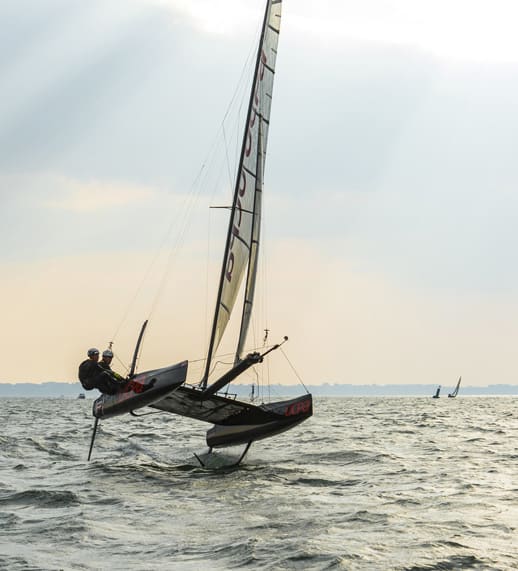
L’UCPA organise des sessions découverte sur son tout nouveau catamaran à foils de 18 pieds (6 m), appelé Flying Phantom, basé à Lorient, au sein du plus gros pôle de course au large d’Europe. Véritable bateau de course qui peut atteindre jusqu'à 60 km/h, cet engin est habituellement réservé à une élite. Depuis mars 2016, l’UCPA organise des stages grand public pour embarquer à bord du Flying Phantom avec un skipper professionnel, moniteur UCPA. L’objectif est d’aller chercher des sensations fortes de vitesse et de vol lors de sorties à la journée ou à la demi-journée. Accompagnés par le moniteur, le pratiquant apprend également à utiliser les multiples commandes et spécificités du bateau. Une expérience de vol totalement inédite en perspective !
Informations pratiques Une session d’une demi-journée coûte 300€ (2h30 environ) Réservation : 02 97 05 50 50
Le Flying Phantom invité du Grand Prix Guyader à Douarnenez
Du 30 avril au 1er mai 2016, le catamaran Flying Phantom sera présent sur le « Défi-Nautic ». Et du 2 au 8 mai 2016, des skippeurs UCPA seront présents sur l’évènement afin de faire tester le Flying Phantom et délivrer des baptêmes aux personnes qui auront réservé leur créneau de navigation à l’avance.
Informations pratiques Horaires : 9h à 12h et 13h30 à 18h30 (sous réserve des conditions météos)
Durée : environ 1h (équipement, briefing et navigation)
Réservation : [email protected] ou par téléphone 02 97 05 50 50
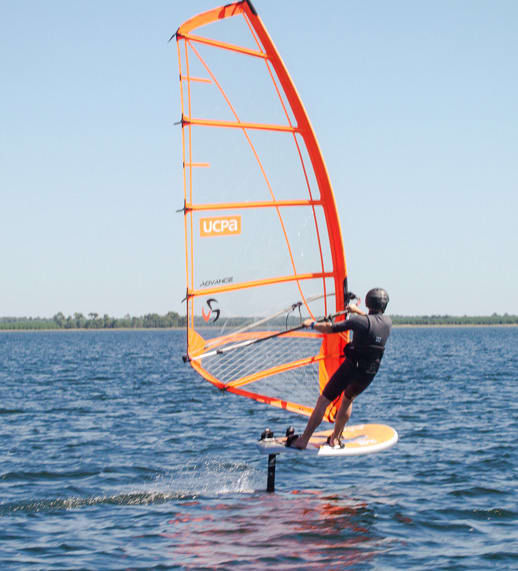
Les premiers stages de planche à voile à foil grand public
L’école de foil ucpa ouvre au grand public ses premiers stages de planche à voile à bombannes en gironde dès le mois de mai.
Ces stages sont ouverts aux personnes qui pratiquent déjà le windsurf. Qu’ils durent une semaine ou quelques jours, ils sont conçus pour alterner perfectionnement du windsurf sur matériel classique (virements de bord, navigation au planning, manœuvre, comparatifs réglages et vitesses) et découverte des sensations foil (premiers vols, nouvelles sensations et maîtrise des équilibres). En parallèle, les centres UCPA de l’Aber Wrac’h, Bénodet, Vaires-Torcy, Hourtin, Port-Barcarès, Port-Camargue, Hyères et Le Vauclin en Martinique seront équipés dès cet été pour proposer aux personnes dont le niveau le permet de découvrir le foil à la fin de leur stage de perfectionnement windsurf et kitesurf, ou lors de cours particuliers pour les pratiquants déjà autonomes qui souhaitent tester le foil avant de s’équiper, le matériel étant onéreux.
Informations pratiques
Stages d'une semaine du 24 juillet au 4 septembre 2016, à partir de 515 €. Stage de 4 jours le 5 mai à 299 €. Stages de 3 jours les 14 mai, 2 septembre et 9 septembre 2016 à 235 €. Réservation sur UCPA.com
Les séjours windsurf foil à l'UCPA
Séjours UCPA en planche à voile à foil
Comment bien commencer le foil ?
Il faut être bien équipé et protégé : combinaison intégrale, chaussons ou bottillons, gilet renforcé contre les impacts, casque…
D’autre part, il faut privilégier une zone de navigation en eau profonde et plutôt dégagée.
Le vent doit être modéré force 3-4, et de préférence parallèle à la plage.
En kitesurf comme en planche à voile, il faut être capable de naviguer sans difficulté au planning. Pour progresser rapidement, le mieux est de choisir du matériel accessible.
Articles liés

Séjours et tendances
VTT / VTC électriques : pédalez branché !

Osez le trail !
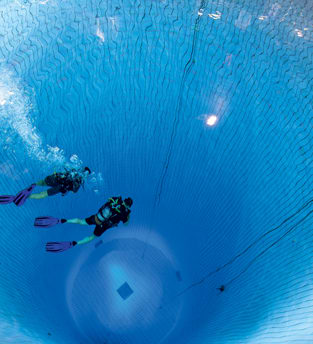
séjours et tendances
4 fosses pour pratiquer la plongée et l'apnée toute l'année !
Le groupe UCPA
- Découvrez l'UCPA
- Domaines d’activité
- Consultez nos offres d'emploi sur UCPA recrutement
- Pourquoi nous rejoindre
- Découvrez nos formations
Nos autres sites
- Découvrez nos séjours
- Rejoignez la communauté UCPA
- Mentions légales
- Plan du site
- Accessibilité

Professional BoatBuilder Magazine
The efficiency of a foiling powercat.
By Dieter Loibner , Mar 13, 2020

Matanzas Watercraft’s founder, Jan Brandt, in his office with a rendering on the wall and the prototype of the Matanzas 29 foiling powercat peeking through the shop door.
Motivated by his own boating experience and America’s Cup foiling technology, a startup builder launches the Matanzas 29, a new breed of powercat for fishing and cruising.
Wherever Jan Brandt goes, a constant companion since his childhood days in Hamburg, Germany, is his passion for watersports. Competitive swimming, surfing, waterskiing, fishing, scuba diving, sailing, you name it, he’s done it—and still does. No surprise, then, that Brandt is also deeply involved with boats, not just using them but also designing and building them. His latest project is a 29 ‘ (8.8m) foil-assisted planing cruising power catamaran designed for twin outboards from 60 hp to 90 hp. Last fall, construction was far advanced as Brandt prepped for finishing, outfitting, and getting the boat ready for sea trials off St. Augustine, Florida, where he set up shop as Matanzas Watercraft LLC.
Inspired by the Sliver 29, a catamaran designed for fishing and weekending, built by SuperCat in South Africa , Brandt defined specifications that suited his own use patterns and his home port in St. Augustine. “I am looking to build a day-use cat for fishing offshore waters but also capable enough to make the run to Bimini and Abacos on a calm summer morning,” his design brief reads. Also on the list: sufficient load capacity for three to four people for day use and provisions for a couple to cruise for a few days; a range of 200 nm on one tank; and a cruising speed of 20 to 25 knots. Brandt: “I need to deal with a 2–3 ‘ [0.6m–0.9m] chop and Atlantic Ocean swells. While an open cockpit with center console and hardtop is totally sufficient, a head and dry storage for gear with maybe just enough space for a bunk for two would be awesome.” Since crab or lobster pot buoys are not much of a concern in Florida, Brandt explored the idea of foil assist to reduce power requirements and improve seakeeping. However, he was adamant about the ability to safely beach the cat and limit overall beam to 9.1 ‘ (3m) to keep the trailering permits manageable.

The Matanzas 29 plywood/carbon prototype has wave-piercing bows with a positive rake and peaked decks that shed water quickly. The bows’ fine entry flattens out toward the stern to encourage planing, even when operating without foils.
He did some preliminary design work himself, but when the project got serious he consulted with Bieker Boats of Anacortes, Washington. Principal Paul Bieker served as the lead designer of the Oracle America ’s Cup sailing team and was instrumental in developing the outrageously fast 72 ‘ (22m) foiling catamarans that ushered in a foiling revolution following the 2013 Cup on San Francisco Bay. Bieker now applies variations of the foiling concept to pleasure craft, most recently with an innovative 53 ‘ (16m) sailing catamaran intended for racing and weekend cruising (see “ Fledging the Eagle ,” Professional BoatBuilder No. 182) and now with Brandt’s foiling powercat.
The basic idea behind foiling is maximizing efficiency while curbing the need for big engines, a notion that has yet to find footing with production boatbuilders. Brandt: “I’m not interested in boats over 25 ‘ [7.6 m] running 250- or 300-hp twin motors. I’ve been doodling around for a year on the idea, spent more time on the hullform, and when I decided to pull the trigger on building one, that’s when I contacted Paul to help me finalize the design, incorporate some of the design criteria and requirements, and make it work from an engineering perspective. He helped crystallize the hull shape and get the details fleshed out.”
Foiling Tech Trickle-Down
A former racing sailor who campaigned a Mini 650, Brandt met Bieker in 2010 while cruising the waters of Puget Sound. He ran his own environmental consulting firm in Seattle and also took up boatbuilding. First came stitch-and-glue kayaks, but soon he graduated to the PT Skiff, an 18′ (5.5m) kit boat by Port Townsend Watercraft designed by Bieker and Russell Brown. With Brown’s encouragement Brandt designed and built the cedar-strip carbon composite Syhoya , a handsome 21 ‘ (6.4m) weekend cruiser powered by a 60-hp Evinrude E-Tec outboard for cruising Puget Sound and beyond.

Previously, Brandt designed and built Syhoya, a 21’ (6.4m) weekender with a 60-hp outboard for cruising the coastal waters of the Pacific Northwest.
In Brandt’s painstakingly clean and organized workshop a 10-minute drive from his house in St. Augustine Beach, Bieker’s plans laid out on the workbench and the prototype of the Matanzas 29 under construction showed how personal predilection, boating experience, and exposure to innovative design ideas informed his choices. For a simple boat that aims to maximize efficiency and minimize power requirements, the design process was complicated. Some salient features, like the combination of planing hulls with wave-piercing bows and the foil arrangement most commonly associated with fast sailing cats, seem a bit counterintuitive at first, but Brandt explained the underlying thinking.
He wanted to minimize the fatigue of the acceleration/deceleration forces when running the steep chop of St. Augustine Inlet during an outgoing tide, “letting the bows do the work,” rather than endure slamming, Brandt explained. “That’s when we combined the wave-piercing hulls with the foil assist in order to get away from larger engines while still being able to carry the displacement we need, all the things we added that were part of my criteria—the fish boxes and the scuba gear. All that weighs quite a bit, [but we wanted] to manage that with reasonably small motors. That’s how we got to wave-piercing bows and the foils.” Load-carrying capacity, especially at speed, is another reason he decided against displacement hulls.

Passengers can ride on the main deck, under the hardtop, or on the “rumble seat” forward.
Why plywood/composite instead of carbon-reinforced plastic construction, which would have further minimized weight? Brandt reasoned it was less complex and costly for a prototype that has to establish proof of concept and test the nascent market for foiling powerboats. Tooling up for a production run is his goal. The thin plywood—okoume 6mm/1⁄4 “ for the topsides, 9mm/0.35 “ for the bottom—is sheathed in E-glass, a laminate schedule of 200-g (5.9-oz) and 300-g (8.95-oz) layers inside and out. Turn Point Design in Port Townsend cut the kit, based on design files it received from Bieker Boats. “That worked perfectly. We have had zero issues with the wood fit,” Brandt recalled. “Every puzzle joint fit the first time.” For the foam-core portions of the boat, he used 20mm (0.79 “ ) Divinycell H80 sandwiched between multiple layers of regular-modulus carbon woven roving of 5.9 oz 0°/90°, and 2×2 twill weave of the same weight, which conforms well to complex 3D shapes. For taping and to reinforce high-load areas, Brandt applied 400 g/m2 (11.8 oz/sq yd) of 45° double biaxial carbon and 9 oz/sq yd (305 g/m2) unidirectionals.
The entire wet deck, measuring 18 ‘ x 10 ‘ (5.49m x 3.05m), was vacuum-bagged with the foam core and three layers of carbon fiber on each side, laid up in various directions. That’s a large piece to build in a compact workspace, so he tackled it first and then stored it against the wall to make room for hull construction. Florida’s warm, humid climate imposes its own demands on working with resins, which ideally are catalyzed and processed in an ambient temperature around 65°F (17°C). Brandt planned to get the big parts done during the cooler time of year, turning on the air-conditioning if necessary and starting at 3 a.m. Doing “the large areas of the hull, we had three layers of glass on the bottom, so running that over 30′ [9.14m] in one shot, even just hand layup, gets challenging, because the initial pot cures before you have the last layer on.” That’s a herculean task for one, but he had help from his wife, Tonya, and then hired some neighborhood kids to do some sanding.

This angle shows the square sterns, the cutouts for the fuel hoses and steering lines, the carbon-reinforced main deck, and the storage boxes.
In addition to all this new construction, Brandt still found opportunities to include some repurposed parts from his Mini 650, which he had raced from Newport to Bermuda and in West Coast regattas. In his stash of spare kit was an extra boom—a 3.7m (11.15 ‘ ) raw carbon tube from CST Composites that always traveled with the boat. It became the beam that holds the anchor roller and forms the front terminus of the foredeck, Brandt noted, adding that he cut and fit sections of carbon spinnaker poles to support the cat’s hardtop.
Outboards with Mustache Foils
As originally conceived, the boat was to be powered by twin 60-hp Suzuki DF 60A three-cylinder outboards. However, working with technicians at Suzuki Marine of North America , which rents shop space from him next door, Brandt opted for the four-cylinder DF 90A, which he considered a better fit for the prototype’s offshore work and for testing the custom mustache foils. Granted, the DF 90A packs 50% more power and a third more weight than a DF 60A, but it’s still modest compared to twin 300s often seen on boats of similar size.

Custom-designed carbon mustache foils on the cavitation plate will boost stern lift as their attitude is adjusted by the tilt and trim mechanisms of the outboards.
“I don’t need 55 knots; 25 is awesome. That’s fast cruising,” he declared. “Every now and then…it’s nice to be in the 30s to run home, but that’s plenty.” If it sounds extreme, Bieker wanted even less. “I think he was initially uncomfortable with the speeds I wanted, until we had a discussion about what the market expects,” Brandt laughed. “The mentality is ‘I gotta be able to go 30, gotta be able to outrun a thunderstorm. I’ve got 40 or 50 miles to the Gulf Stream, and I want to get there in reasonable time.’ Paul’s sweet spot is 15, 16 knots, because you can do that with a lot less power. To go from 16 to 22 knots is a big jump, but 16 knots is not where the market is; it’s not where the utility of the boat is. So I had to push the area of power where he was less comfortable and the threshold of where he did not want to be associated with. That was a big compromise. I credit him for coming my way.”

Outward-facing J-foils forward carry most of the displacement when deployed. Their angle of attack is manually adjustable by ±2° with a sliding bolt, and hinge pins allow the foils to fold up when not in use.
The production of the mustache foils (named after their shape) was outsourced to Chris Maas on Center Island, Washington, a former builder of custom rowing shells and International Sailing Canoes. He said he was using his 3-axis CNC router to machine molds from MDF board and construct the foils in wet layup with Pro-Set epoxy. These foils will be mounted to the cavitation plate, so any adjustment in the angle of attack comes from the outboards’ tilt and trim mechanisms. The main appendages amidships are outward-facing J-foils (similar to those on the 31 ‘ /9.45m Foiler by Enata Marine; see PBB No. 173, pages 39–40). A hinge pin at their heads allows them to fold up when not in use, while the angle of attack is adjusted manually when the boat is stopped, by slacking two bolts and sliding the hinge mechanism fore and aft for a range of ±2°.
“We lofted all the layers carefully,” Bieker said of the foil construction that was performed by Simon Miles, a carbon fiber fabricator in Port Townsend. “We came to 167 layers,” Bieker continued. “Typically we get to within 1mm of the target shape. The structural spar is solid, and toward the trailing edge there’s some hi-temp PVC foam core.” It will be done in five to six cooks at 250°F/121°C (see the sidebar below).
In foiling mode the cat will not be in “full flight” with hulls clear of the water but rather skimming along the surface. As simple and sensibly powered as the boat is, Brandt still wants the capacity to carry a payload of approximately 1,600 lbs (725 kg) for fuel (2 x 35 gal/132.5 l), water (14 gal/53 l) food, paddle, and surfboards, fishing, and scuba gear, a porta-potti, some electronics, and a small refrigerator. To cover his energy needs for starting and house loads, he’ll go with 2 x 75-Ah lead-acid batteries with 650-amp cold-cranking capacity. Two 100-watt solar panels on the hardtop and intermittent charging from the alternators when motoring should keep the lights on and the beer cold.

Deck, stern, and side views reveal the arrangement of the boat with foils deployed and folded up. Note the mustache foils mounted to the cavitation plates of the outboards to increase lift and help trim the boat.
Brandt named his company Matanzas Watercraft after the river that runs past St. Augustine, where he attended high school after emigrating from Germany with his family in the 1980s. Dating back to those days, he knows the surf spots, gnarly riptides, and choppy patches where sea breeze and ebb collide. After dialing in the new boat during sea trials, which include a trip to the Bahamas to test it as a cruising, fishing, and diving platform, he hopes this America ’s Cup–inspired concept will generate the interest that warrants a limited production run. Ideal customers, Brandt reckoned, are sailors who share his passion for water sports, value his high-tech approach to efficiency, and “don’t necessarily need the power that generally is the norm in the market.” It’s a bold bet but one that seems right for the times. “The intent is there, and we have the facilities to do it,” he added.
Dieter Loibner is editor-at-large of Professional BoatBuilder.
Cooking the Foils
While Jan Brandt of Mantanzas Watercraft was putting the finishing touches on his Matanzas 29 powercat in St. Augustine, Florida, the foils were being made at the diagonally opposite corner of the lower 48, in Port Townsend, Washington, roughly 2,500 miles (4,023 km) distant. Working inside his barn workshop that used to house a boatbuilding shop called Seven Seas, carbon fiber technician Simon Miles, 31, stood next to the carbon tool he’d built for the job. He was warming swatches of prepreg with a heat gun to help them stick to the adhesive film he had previously put on top of the cured substrate of the first cook.

Simon Miles heats the prepreg to bond it to an adhesive film he put down onto cured substrate in the foil mold.
Having worked for Oracle’s America ’s Cup team and Mad Fiber, a Seattle company that made high-end carbon racing wheels, Miles is very much at home with high-end carbon work, but this job was new territory, because it required high-temperature tooling, and he was using a new source for the intermediate-modulus prepreg required.
The tooling was built from a plug of machined medium-density fiberboard (MDF). The monolithic carbon mold is infused with Pro-Set High-Temp infusion resin using Sigmatex 660 g/m2 (19.5 oz/sq ft) of 2 x 2 twill, a ply of 200-g/m2 (5.9-oz/sq-ft) woven carbon, and two coats of Pro-Set High-Temp tooling putty against the machine-tool-face end to limit print-through of the heavy woven cloth.

Infusion of the carbon tool.
The centerpiece of the foil project is a 20 ‘ -long (6.1m) shipping container the previous owner converted into a giant oven for constructing high-end carbon fiber parts. “It has Roxul insulation and stainless walls inside,” Miles explained, “and there is a huge heater/blower unit from Electroheat.” For this project, Miles moved the container/oven into his workshop and hooked it up to three-phase power.
To help lower the cost, Miles sourced 108 yd of 190-g/m2 (5.6-oz/sq-ft) unidirectional 250 prepreg from Composite Recycling Technology Center (CRTC) in Port Angeles, Washington. The material was rejected for use in aerospace applications, hence the substantial savings. At CRTC it was stored at 0°F (–17.8°C), which is common for prepreg. Once out of the freezer it must be processed quickly, but the cool ambient temperatures of the Pacific Northwest winter (at or below 50°F/10°C) allowed Miles enough time to complete the work.

Some complexities: The foils, designed by Bieker Boats, comprise 167 layers of carbon laminate, 144 of them unidirectional 0°, the rest off-axis plies (±45°). In the lower part of the foil, the structure will include foam core (Divinycell H100 foam) and Gurit SE 84 laminates. Miles said he planned to switch to the lower-temperature prepreg so the foam does not “blow up.” At 250°F (121°C) H100 distorts, changing density and dimensions, but SE 84 cures below that threshold at a cooler 176°F (80°C). Miles said he would still precook the Divinycell to reduce the chances of expansion after the foam had been shaped. To finish, he will use woven cloth for wrapping, and SE 84 as well. Lastly, the B-side will be faired and sanded.
Miles estimated total construction time would run eight weeks for a springtime delivery.
Dieter Loibner
Read more Companies , Construction , Design articles

- Van der Werff’s Curved Wood
A Dutch yard adopts composite panel molding technology to build boats from preshaped wooden hull sections.

- Departures: Carl Chamberlin
Passionate, competent, considerate, modest, and thoughtful is how designer and boatbuilder Carl Chamberlin is remembered by those who knew him. He died last November at age of 75 in Port… Read more »

- SAFE Boats Regains Small-Business Status with Employee Ownership
More than 20 years ago, Professional BoatBuilder ran a feature titled “God, Country and Fast Boats” (No. 85, page 64) about SAFE Boats International (SBI), a Bremerton, Washington–based manufacturer of aluminum boats…. Read more »

Recent Posts
- Find out how 3D printing can help your boatbuilding with MASSIVIT
- SNAME Powerboat Symposium Is Back
- Companies (85)
- Construction (106)
- Design (161)
- Drawing Board (10)
- Education (25)
- Environment (16)
- Events (21)
- Materials (50)
- Obituary (18)
- People/Profiles (49)
- Products (16)
- Propulsion Systems (32)
- Racing (16)
- Repair (37)
- Rovings (317)
- Short Cuts (3)
- Sponsored Partner News (14)
- Systems (80)
- Task Sheet (1)
- Uncategorized (26)
- Wood to Glass (7)
ProBoat.com Archives
Catamaran Sailing
Catamaran sailing, or 'cat sailing' for short is the fastest, most exciting form of small boat sailing. ucpa have a large range of hobie cat 16's which will help you learn the basics of rigging, launching, tacking, gybing, sailing upwind and sailing downwind., always included in our holidays, accommodation, instruction or guiding, friendly & social atmosphere, all necessary sailing equipment, what level do i need to be keyboard_arrow_down.
The catamaran trips are open for complete beginners to advanced level sailors. Usually there are several groups running at the same time, so groups are formed according to ability and the course content is adapted.
Do I need to know how to tie any knots already?
Of course not, that is why you are on a sailing trip, to learn and improve on your sailing skills!
What basic sailing knowledge will I learn? keyboard_arrow_down
- Understand the points of sailing; close hauled, close beam & broad reach and on a run
- How a catamaran works; the physics of sailing, how to set up the Hobie cat etc
- Understand how to recover a person overboard
- Understand the dangers you might come across at sea and on the boat
- Understand the basic sailing rules
- Looking at weather forecasts- wind strength effects on sailing conditions
- Learning about tides
What skills will I develop? keyboard_arrow_down
- Balancing the Hobie Cat
- Sail ‘close hauled’ on a ‘close beam’ and ‘broad reach’ and on a ‘run’
- Tack towards the wind (upwind sailing)
- Gybe from a ‘broad reach’ to a ‘broad reach’
- Stopping the boat at any given time
- Can ‘right’ a capsized Hobie without assistance
- Prepare for and takeup a tow from a powerboat
- Beach landings
What happens if there is no wind? keyboard_arrow_down
There is a minimum "ideal" wind level for the boat too that is probably around 4-5 knots. Below 4-5 knots, you start having problems with the sails. If there is a lack of wind, UCPA will offer alternative activities such as sea kayaking, paddle boarding, cycling or hiking.
How fast can a Hobie16 go? keyboard_arrow_down
The max speed is nearly 24-knots and there are plenty of Hobie sailors who will agree and verify. Average speed for a hobie 16 is around 14knots, but obviously this is completely wind dependent so it is tricky to say!
What kit is required? keyboard_arrow_down
UCPA will provide you with a lifejacket. Be prepared for protection from the sun, with a cap/hat, UV rash vest/long sleeved top, suncream and sunglasses. Flip flops are assumed to be the best footwear for a boat, however a waterproof/resistant shoe with good grip is actually much more suitable as they are less likely to come off whilst at sea. Something as simple as neoprene socks will work well as they will protect your feet from getting cut.
Sea friendly suncream- We want you to protect the sea, but we also want you to protect your skin without threatening the environment. The best option at the moment for eco-conscious sea lovers is to swap out those chemical sunscreens for ones with mineral ingredients like zinc oxide or titanium dioxide that reflect the sun off your skin, without threatening the environment.
View all dates & prices for Catamaran Sailing
Prices from, what our clients say about us, easy for solo traveller, "all ucpas are very friendly and sociable. the bar and dining areas are open with big tables, encouraging people to sit together and get to know each other. this makes it very easy as a solo traveller.", unique and brilliant experience, "ucpa is a unique and brilliant experience, i would not describe it as a hotel but also not hostel it is somewhere in-between. its a place where meeting people and making friends...", making new friends, "there is always such a friendly and open atmosphere and the nights provide a great opportunity to meet new people. making new friends from all over the world is a virtual certainty and for me personally, this was the...", heartedly recommend ucpa, "i can whole heartedly recommend ucpa to anyone, experienced riders or total novices alike will absolutely love it.", totally unique set-up, "ucpa is a totally unique set-up, providing both a top-level skiing service and a wonderful place to relax and enjoy yourself. ", the best holiday, "there isn’t a part of ucpa that i don’t enjoy, it’s some of the best holidays i’ve had and going to have.", subscribe to our newsletter.
Join our newsletter and get news in your inbox every week! We hate spam too, so no worries about this.

- Accueil >
- Loisirs nautiques >
- Location ou initiation de voile légère, de planche à voile >
- Présentation
- Localisation
Loisirs nautiques Adultes et Enfants
Stages sans hébergement enfants de 5 à 17 ans : Vacances scolaires en Avril et Octobre à l'Ecole de Mer (à partir de 7ans) Juillet-Août (à partir de 5 ans ) Base annexe de Plage-Sud Les stages avec hébergement enfants de 6 à 17 ans se déroulent pendant les vacances scolaires, 2 sites d'hébergement : Ecole de Mer de Port-Camargue ou le camp UCPA au Camping de l'Espiguette. (suivant la période et l'âge de l'enfant) Stages adultes : Mai-Juin et week-ends Juillet à fin septembre : en semaine. Accueil séjours groupes, CE, séminaires .. toute l'année à l'Ecole de Mer Renseignements et réservations au 03 28 82 92 92
- Activité encadrée
- Cours collectif
- Stage d'initiation
- Stage de perfectionnement
- Association nautique
- Ecole de Voile
- Planche à voile
- Voile légère
- Tout public
- Accueil scolaires

- (321) 878-3645
Come Visit Us in St. Pete Jan. 19th - 23rd
Come Visit Us in Miami Feb 15 - Feb 19 - Sea Trials on the Hour
Come Visit Us in Palm Beach Mar 26 - Mar 29 - Sea Trials on the Hour
Experience the Game Changing Difference
Upcoming Sea Trial Events
- St. Pete Boat Show – (Jan 19 – 23, 2023)
- Miami International Boat Show – (Feb 15 – Feb 19, 2023)
- Palm Beach Boat Show – (Mar 26 – Mar 29, 2023)
Unique Engineering
The foil assist.
- Ultimate Performance
- Patented Morrelli & Melvin Hull / Foil System
- Bespoke-built, Epoxy-Infused Hulls
The New Paradigm
- High Quality
- Unmatched Performance & Efficiency
- Unlike Any Other Center Console on The Market
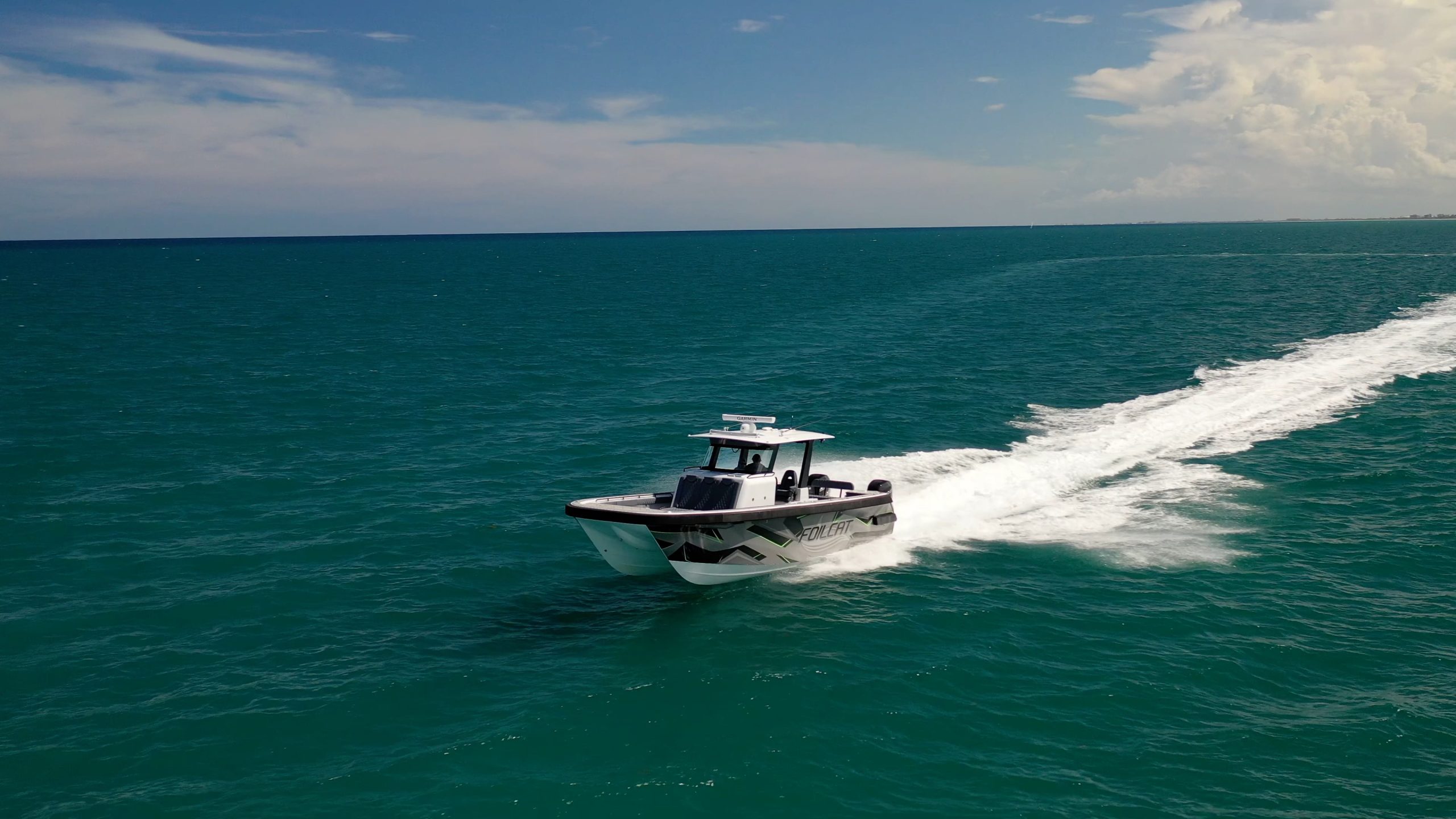
What People Are Saying

Why Foilcat?
The FoilCat Team is relentlessly dedicated in our pursuit of the ultimate user experience accentuated by the highest performance and safety standards throughout the marine industry.
A RIDE LIKE NO OTHER
The foil greatly improves ride quality and efficiency. Reduction in operator and passenger injury and fatigue.
CUSTOMIZABLE
Built to suit from collars to cabin tops and the engines on the back. We work with you to create your dream watercraft.
IMPROVED RANGE
A greater range on same volume of fuel vs any other platform. Our models are 40-50% MORE fuel efficient than our market competitors.

Support our hydrofoil educational content for free when you purchase through links on our site. Learn more
[2023] Hydrofoil Catamaran: The Ultimate Guide to Foiling on Water
- November 1, 2023
- Hydrofoil Basics
Experience the thrill of flying above the water with a hydrofoil catamaran!
Are you ready to take your hydrofoil boarding to the next level? Look no further than the hydrofoil catamaran. In this comprehensive guide, we’ll dive deep into the world of hydrofoil catamarans, exploring their history, how they work, their benefits and drawbacks, and everything else you need to know to make an informed decision. So, buckle up and get ready to soar above the waves!
Table of Contents
Quick answer, quick tips and facts, how does a hydrofoil catamaran work, benefits of hydrofoil catamarans, drawbacks of hydrofoil catamarans, choosing the right hydrofoil catamaran, maintenance and care, recommended links, reference links.
A hydrofoil catamaran is a type of watercraft that combines the stability of a catamaran with the lift and speed of hydrofoils. It uses specially designed foils to lift the hulls out of the water, reducing drag and allowing for faster and smoother sailing. Hydrofoil catamarans are popular among sailors and water sports enthusiasts for their incredible speed, maneuverability, and thrilling foiling experience.
Shopping Links: Hydrofoil Catamarans on Amazon | Hydrofoil Catamarans on Walmart | Hydrofoil Catamarans on Etsy
- Hydrofoil catamarans can reach speeds of up to 40 knots (46 mph) or more, depending on the design and conditions.
- The foils on a hydrofoil catamaran can lift the hulls out of the water, reducing drag and allowing for a smoother and faster ride.
- Hydrofoil catamarans are used for various purposes, including racing, recreational sailing, and even transportation.
- Foiling on a hydrofoil catamaran requires some skill and practice, but it’s an exhilarating experience once you get the hang of it.
- Hydrofoil catamarans come in different sizes and designs, catering to different skill levels and preferences.
Hydrofoil catamarans have a fascinating history that dates back to the early 20th century. The concept of using hydrofoils to lift boats out of the water and reduce drag was first explored by Italian engineer Enrico Forlanini in the late 1800s. However, it wasn’t until the 1950s that hydrofoil technology started to gain traction in the boating world.
The first hydrofoil catamaran, known as the “Aquavion,” was developed by the French engineer René Guilbaud in the 1950s. This innovative design combined the stability of a catamaran with the lift of hydrofoils, revolutionizing the world of sailing. Since then, hydrofoil catamarans have evolved and become more advanced, offering incredible speed, maneuverability, and stability on the water.
A hydrofoil catamaran works by utilizing hydrofoils, which are wing-like structures mounted underneath the hulls of the boat. These foils generate lift as the boat gains speed, lifting the hulls out of the water and reducing drag. This lift allows the hydrofoil catamaran to achieve higher speeds and a smoother ride compared to traditional boats.
The hydrofoils on a catamaran are typically designed with a curved shape, similar to an airplane wing. This shape creates a pressure difference between the upper and lower surfaces of the foil, generating lift. The foils are usually adjustable, allowing the sailor to fine-tune the performance of the catamaran based on the sailing conditions.
To control the hydrofoil catamaran, sailors use a combination of steering and sail trim. By adjusting the angle of the foils and the sails, they can optimize the lift and balance of the boat, ensuring a stable and efficient ride. It takes some practice to master the art of foiling on a hydrofoil catamaran, but the rewards are well worth the effort.
Hydrofoil catamarans offer a range of benefits that make them a popular choice among sailors and water sports enthusiasts. Here are some of the key advantages of hydrofoil catamarans:
Speed : Hydrofoil catamarans are known for their incredible speed. By lifting the hulls out of the water, hydrofoils reduce drag and allow the boat to glide smoothly above the waves. This enables hydrofoil catamarans to reach impressive speeds, making them a thrilling choice for racing and high-performance sailing.
Maneuverability : The lift generated by hydrofoils enhances the maneuverability of catamarans. With reduced drag, hydrofoil catamarans can make sharp turns and quick maneuvers with ease. This agility is particularly useful in racing scenarios, where every second counts.
Stability : The dual-hull design of catamarans provides inherent stability, even at high speeds. When combined with hydrofoils, the stability of hydrofoil catamarans is further enhanced. This stability makes them suitable for sailors of all skill levels, from beginners to experienced professionals.
Efficiency : Hydrofoil catamarans are more efficient than traditional boats. By reducing drag, hydrofoils allow the boat to sail faster while using less power. This increased efficiency translates to longer sailing distances and reduced fuel consumption, making hydrofoil catamarans an environmentally friendly choice.
Versatility : Hydrofoil catamarans are versatile watercraft that can be used for various purposes. Whether you’re looking for a high-performance racing catamaran or a recreational sailboat for family outings, there’s a hydrofoil catamaran to suit your needs. Some models even offer the option to switch between foiling and non-foiling modes, providing flexibility on the water.
While hydrofoil catamarans offer numerous benefits, it’s important to consider their drawbacks as well. Here are a few potential downsides to keep in mind:
Cost : Hydrofoil catamarans tend to be more expensive than traditional boats. The advanced technology and materials used in their construction contribute to the higher price tag. Additionally, maintenance and repairs can also be costly, especially if specialized parts or services are required.
Learning Curve : Foiling on a hydrofoil catamaran requires some skill and practice. It can take time to learn how to control the boat effectively and maintain stability while flying above the water. Beginners may find the learning curve steep, but with dedication and proper instruction, anyone can master the art of hydrofoil catamaran sailing.
Weather Conditions : Hydrofoil catamarans are sensitive to weather conditions. While they excel in flat water and moderate winds, rough seas and strong gusts can pose challenges. It’s important to be aware of the weather forecast and choose suitable sailing conditions to ensure a safe and enjoyable experience.
Transportation and Storage : Hydrofoil catamarans can be larger and bulkier than traditional boats, making transportation and storage more challenging. Specialized trailers or racks may be required to transport the catamaran, and adequate storage space is needed to protect it when not in use.
Despite these drawbacks, the thrill and excitement of foiling on a hydrofoil catamaran outweigh the challenges for many sailing enthusiasts.
When it comes to choosing the right hydrofoil catamaran, there are several factors to consider. Here are some key points to keep in mind:
Skill Level : Consider your skill level and experience as a sailor. Some hydrofoil catamarans are designed for advanced sailors, while others are more beginner-friendly. Choose a catamaran that matches your skill level to ensure a safe and enjoyable sailing experience.
Intended Use : Determine how you plan to use the hydrofoil catamaran. Are you looking for a racing catamaran, a recreational sailboat, or something in between? Different models offer varying features and performance characteristics, so it’s essential to choose a catamaran that aligns with your intended use.
Budget : Set a budget for your hydrofoil catamaran purchase. Prices can vary significantly depending on the brand, model, and features. Consider both the upfront cost and the long-term maintenance expenses when determining your budget.
Brand and Reputation : Research different brands and their reputation in the hydrofoil catamaran industry. Look for brands with a track record of producing high-quality, reliable catamarans. Reading customer reviews and seeking recommendations from experienced sailors can also provide valuable insights.
Demo and Test Sails : Whenever possible, try out different hydrofoil catamarans before making a final decision. Many manufacturers and dealers offer demo and test sails, allowing you to experience the performance and handling of the catamaran firsthand. This hands-on experience can help you make an informed choice.
Remember, choosing the right hydrofoil catamaran is a personal decision that depends on your individual preferences and needs. Take your time, do your research, and consult with experts to find the perfect catamaran for your hydrofoil adventures.
Proper maintenance and care are essential to keep your hydrofoil catamaran in top shape and ensure its longevity. Here are some maintenance tips to help you keep your catamaran performing at its best:
Rinse with Fresh Water : After each sailing session, rinse your hydrofoil catamaran with fresh water to remove salt and debris. Pay special attention to the foils, as saltwater can cause corrosion over time.
Inspect for Damage : Regularly inspect your catamaran for any signs of damage or wear. Check the foils, hulls, rigging, and sails for any cracks, dents, or loose fittings. Address any issues promptly to prevent further damage.
Store Properly : When not in use, store your hydrofoil catamaran in a dry and secure location. If possible, keep it covered to protect it from the elements. Consider using a boat cover or storing it in a boat shed or garage.
Follow Manufacturer’s Guidelines : Follow the manufacturer’s guidelines for maintenance and care. Each catamaran may have specific recommendations for cleaning, lubrication, and other maintenance tasks. Adhering to these guidelines will help prolong the life of your catamaran.
Seek Professional Assistance : If you’re unsure about any maintenance tasks or need assistance, don’t hesitate to seek professional help. Local boatyards, sailing clubs, or authorized dealers can provide expert advice and services to keep your catamaran in optimal condition.
By following these maintenance tips and caring for your hydrofoil catamaran, you can enjoy many years of thrilling foiling adventures on the water.
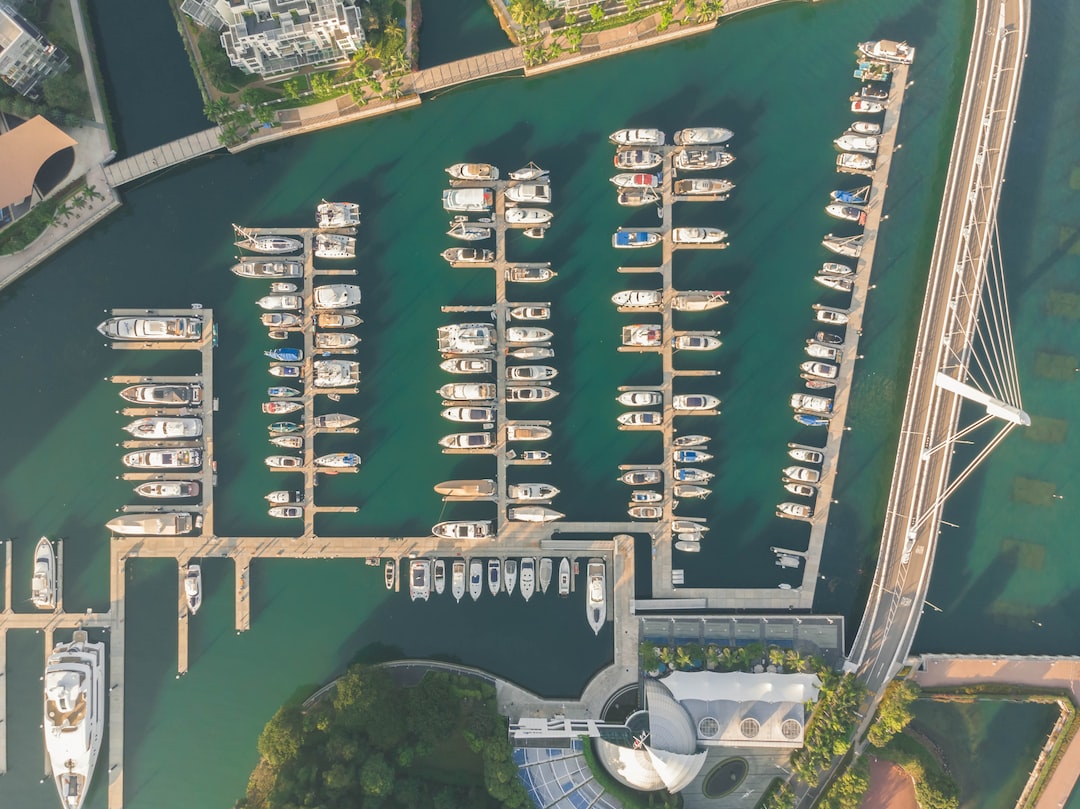
How fast is the hydrofoil catamaran?
Hydrofoil catamarans can reach impressive speeds, depending on various factors such as the design, wind conditions, and skill of the sailor. Some high-performance hydrofoil catamarans can exceed 40 knots (46 mph) or more. However, the exact speed will vary based on these factors.
How does a foil catamaran work?
A foil catamaran, also known as a hydrofoil catamaran, works by utilizing hydrofoils to lift the hulls out of the water. These foils generate lift as the boat gains speed, reducing drag and allowing for faster and smoother sailing. The lift created by the foils enables the catamaran to “fly” above the water, resulting in increased speed and improved performance.
What happened to hydrofoils?
Hydrofoils have a rich history and have been used in various applications, including passenger ferries, military vessels, and recreational boats. While hydrofoils experienced a surge in popularity in the mid-20th century, their use declined in some sectors due to factors such as high costs, maintenance challenges, and the development of alternative technologies. However, hydrofoils continue to be used in niche markets, including high-performance sailing and racing.
Read more about “… What is the World’s Largest Hydrofoil Boat?”
Are hydrofoil boats more efficient?
Yes, hydrofoil boats are generally more efficient than traditional boats. By lifting the hulls out of the water, hydrofoils reduce drag and allow the boat to sail faster while using less power. This increased efficiency translates to longer sailing distances and reduced fuel consumption. However, it’s important to note that the efficiency gains may vary depending on factors such as the design, sailing conditions, and skill of the sailor.
Hydrofoil catamarans offer an exhilarating and thrilling experience on the water. With their incredible speed, maneuverability, and stability, they have become a favorite among sailors and water sports enthusiasts. While they may come with a higher price tag and require some skill to master, the rewards of foiling on a hydrofoil catamaran are well worth it.
When choosing a hydrofoil catamaran, consider factors such as your skill level, intended use, budget, and the reputation of the brand. Take the time to research and test different models to find the perfect catamaran for your needs.
So, are you ready to take flight on a hydrofoil catamaran? Embrace the thrill, experience the freedom, and enjoy the incredible sensation of soaring above the water. Happy foiling!
- Hydrofoil History
- Advanced Hydrofoiling Techniques
- Hydrofoil Equipment Reviews
- Why do boats not use hydrofoils?
- iFLY15 – iFLY Razzor Pro – Foiling Catamaran
- Hydrofoil Catamarans on Amazon
- Hydrofoil Catamarans on Walmart
- Hydrofoil Catamarans on Etsy
Review Team
The Popular Brands Review Team is a collective of seasoned professionals boasting an extensive and varied portfolio in the field of product evaluation. Composed of experts with specialties across a myriad of industries, the team’s collective experience spans across numerous decades, allowing them a unique depth and breadth of understanding when it comes to reviewing different brands and products.
Leaders in their respective fields, the team's expertise ranges from technology and electronics to fashion, luxury goods, outdoor and sports equipment, and even food and beverages. Their years of dedication and acute understanding of their sectors have given them an uncanny ability to discern the most subtle nuances of product design, functionality, and overall quality.
Related Posts
What are hydrofoil ferry vessels well known for [2024] 🚀.
- April 12, 2024
What is a Hydrofoil Ferry? [2024] 🚢
Best hydrofoiling for beginners: a comprehensive guide [2024] ✅.
- April 9, 2024
Leave a Reply Cancel Reply
Your email address will not be published. Required fields are marked *
Add Comment *
Save my name, email, and website in this browser for the next time I comment.
Post Comment
Trending now
- Les séjours sportifs UCPA
- Onelife 18-30 ans
- Le sport au quotidien
- L'association
- Nos formations
- Sports de Nature
- UCPA Sport Trotter
- Sport en ville
- Sport pour tous
- Parlons colos
- Ils / Elles font l'UCPA
- Déconnexion
Windsurf, kitesurf, Catamaran : comment commencer à pratiquer le foil ?
- Accueil >
Publié le 02-06-16
Pratique de niche, réservée à des sportifs expérimentés, le foil se démocratise et s’ouvre désormais à un public amateur de nouvelles sensations fortes . Si sa pratique peut s'avérer un peu technique de prime abord, les sensations sont décuplées et inédites lors de la navigation, par rapport à d’autres sports de glisse comme le kitesurf, le windsurf ou le catamaran.
Le foil modifie radicalement les sensations de glisse
Le foil est à la base l’aileron qui vient s’adapter soit à la coque d’un bateau (catamaran, dériveur), soit à la planche d’une planche à voile ou d’un kitesurf. Grâce à son aérodynamisme exceptionnel, il permet de se maintenir littéralement dans les airs, au-dessus de la surface de l’eau. Plus un bruit, pas un frottement,
On découvre la glisse à l’état pur et la sensation de voler.
Jusqu’alors confidentielle, cette pratique s’est révélée au grand public à l’occasion de la coupe de l’America en 2013, avec la présentation des fameux AC72.
Par Donan.raven — Travail personnel, CC BY-SA 3.0, https://commons.wikimedia.org/w/index.php?curid=28474966
Depuis, l’engouement est au rendez-vous et les grandes marques rivalisent pour sortir des foils toujours plus performants. Ce ne sont plus seulement les connaisseurs, bricolant leurs matos eux-mêmes dans leur garage, qui le pratiquent. Depuis une dizaine d’années, grâce à l’évolution des techniques et des matériaux, cette innovation sportive se démocratise et séduit des sportifs de tous horizons, avides de nouvelles sensations !
Quels pré-requis techniques avant de débuter le foil ?
Mais comme toute pratique sportive nouvelle, il faut quelques pré-requis pour dompter ce nouvel outil. Comme nous l’avons vu dans l’article "Quand commencer le foil", il faut déjà être à l’aise et autonome sur des supports tels que le Stand up paddle (SUP), le surf, le kitesurf, le windsurf ou le catamaran . Le pratiquant doit savoir bien percevoir son environnement, s’assurer des bonnes conditions météo, prendre ses repères par rapport à la zone de navigation. Au cours d’un stage sur du matériel plus classique, le moniteur évalue la technique, le degré d’autonomie et les manœuvres connues du pratiquant : l’aisance au harnais, la navigation au planning, savoir tirer des bords . Si un élève se révèle particulièrement doué au cours d’un stage de perfectionnement windsurf, kitesurf ou voile, une première approche du foil lui sera proposée. Pour le catamaran, le niveau d’accessibilité est un peu plus bas.
On peut emmener presque tout le monde à bord d’un flying phantom
A partir du moment où on sait se mettre au trapèze en équipier !
Le moniteur se concentre sur la barre, tandis que l’équipier s’occupe de la grand-voile, un poste moins contraignant. Le foil, c’est vraiment l’occasion de tenter une nouvelle expérience de glisse, plus aérienne et originale . En plus, la pratique est encore émergente en France : un bon moyen d’épater ses amis !
Des sensations surprenantes sur un support connu
Comme nous l'avons vu dans notre article " Quel niveau faut-il avoir pour commencer le foil " Il faudra un peu de temps avant de devenir un as de la navigation sur foil. Même si le pratiquant connaît le support, la navigation n’a rien à voir avec les autres sports et demande de la rigueur. Il y a notamment beaucoup de notions nouvelles, de schémas psychomoteurs à changer et plusieurs éléments de sécurité à appréhender lors de l’apprentissage.
Faire appel à un moniteur ou suivre un stage spécialisé en groupe permettra de progresser et se faire plaisir rapidement.
Ses conseils permettront d’acquérir de bonnes bases, d’évoluer sur le plan d’eau en souplesse et d’apprendre à maîtriser ses gestes au pilotage, dans un environnement sécurisé. On découvre alors des sensations surprenantes et nouvelles , sur un support que l’on pensait déjà connaître à fond, c’est là toute la magie du foil. Quel plaisir de relever le challenge !
On touche du doigt à ce qui se fait de mieux en logique d’utilisation du matériel.
Des techniques pour progresser plus vite
Le choix des conditions de navigation est bien plus important que ce que l’on pense pour progresser. Certes, avec un foil, on peut naviguer dans très peu de vent. Mais quand on débute,
Il est préférable de naviguer dans un vent modéré, ni trop fort, ni trop faible, sur un plan d’eau pas trop agité.
Cela permet au pratiquant d’avoir davantage de repères et de maîtriser plus facilement sa voile pour se concentrer sur la planche. Avant de pouvoir faire des allers-retours dignes sur le plan d’eau, il faudra également travailler son équilibre, revoir la qualité des appuis sur les jambes et le positionnement du poids du corps. Pour dompter un engin à foil, l’agilité, l'équilibre et la souplesse priment sur la force . Le support est en effet très réactif et nécessite un pilotage en finesse qui fait appel à tous les sens du pratiquant. L’objectif est de gérer la montée et la descente, le tangage et le roulis . Puis de travailler en souplesse les transitions, mais là tout dépend de l’agilité du pratiquant. Sachant qu’il n’y a que les champions du monde qui réalisent des transitions parfaites !
Dois-je acheter mon propre matériel pour débuter ?
Comme la pratique n’est pas encore démocratisée, l’équipement de foil reste très onéreux . Le pratiquant expérimenté, passionné, dispose souvent de son propre matériel, sur lequel il va falloir ajuster un aileron : le foil. C'est un investissement supplémentaire de 1 500 à 2 000 euros qui peut en freiner plus d'un. Une planche de windsurf avec un foil coûte entre 4 000 et 5 000 euros, auquel il faut rajouter ensuite une voile. À cet équipement s'ajoute toute la panoplie sécurité indispensable à la pratique des sports de glisse combinaison intégrale, chaussons ou bottillons, gilet renforcé contre les impacts, casque.
Dans le cas d’une pratique intensive et locale, il est tout à fait envisageable d’acheter son propre matériel
Mais, avant de vous équiper entièrement, il est fortement recommandé d’effectuer un stage de découverte ou de perfectionnement pour découvrir ces nouvelles sensations. Cela vous permettra de progresser plus rapidement et de voir les bénéfices d’un accompagnement personnalisé avec un moniteur expérimenté.
Où débuter la pratique du foil ?
Les meilleurs spots combinent une zone dégagée et profonde, pour ne pas abîmer le matériel, et un vent modéré force 3-4 et de préférence parallèle à la plage. Les centres équipés de Bombannes en Gironde, à Port Camargue dans le Gard, à Port Barcarès dans les Pyrénées Orientales, ou à Lorient dans le Morbihan, sont des spots qui disposent de toutes ces qualités pour aborder le foil dans les meilleures conditions
Un article de CRemy
Yachting World
- Digital Edition

Eagle Class 53: The foiling cruiser inspired by the America’s Cup
- Matthew Sheahan
- August 6, 2019
Is this the future of sailing? The Eagle Class 53 is a wingmasted cruising catamaran designed to fly on T-foils
Not everything that flies is destined to scorch around an America’s Cup course. The future for sailing hydrofoils is surely about more than just racing. At least, that was the view of one owner who, having witnessed the America’s Cup foiling catamarans, saw a big opportunity.
“I’ve worked as a skipper for yacht owner Donald Sussman for 16 years,” says Tommy Gonzalez. “When he saw the foiling Cup boats he knew that this was what he wanted to have a go at. He is not interested in racing himself, he wanted to go cruising, but cruising on foils. He saw what had been created and believed that this had practical potential. Put simply he said: ‘I want one and I want to be the first.’”
As well as being a professional skipper, Gonzalez is the president of Fast Forward Composites, a Rhode Island-based composite building facility where the Eagle Class 53 was constructed. Understandably, the road to creating such an ambitious cruiser was never going to be straightforward. So the plan was structured around several key elements and stages, starting with an efficient and easily managed wingmast.

The hybrid solid wing and soft sail configuration means the rotating rig can be reefed. The entire solid wing can be rotated through 360° ensuring the rig can always be fully depowered – important for docking and close quarters manoeuvring
Of those two criteria, efficiency is easy to satisfy – wingmasts are by definition more efficient. It is the practicalities of handling them that usually causes problems. Reducing sail in breezy conditions and leaving the wing up at the dock are two of the biggest issues.
The solution on the Eagle Class 53 was to create a composite wingmast where 50% of the area is a solid D-section and the trailing 50% a soft sail that can be raised, lowered and reefed. Interestingly, it is a similar concept to that of the next generation of 75ft foiling monohull Cup boats, currently under development. “The rig is a little lighter than a conventional mast and sail set up, and significantly easier to handle,” explains Gonzalez.
“Because the sail can be raised or lowered we can reef the main, or even just sail with the solid section. The mainsheet loads are around 40% less than a conventional rig and because the sail can turn 360° we can let the wingmast fully rotate, which makes life simple when you’re docking. You just let it feather.
“In addition, because we have a part soft sail, which we have developed with North Sails, we can create twist which allows us to de-power the top of the sail, so we have plenty of control over this wing and the advantages that go with it.”
Article continues below…

Could the wonderfully weird Inflated Wing Sail make sailing easier?
As the mist rose off the water’s surface in the picturesque harbour of Morges on the north bank of Lake…

Baltic 142: The superyacht bringing foiling technology into cruising
The Baltic 142 may not be using the hydrofoils popularised by the America’s Cup, but her 29ft 6in long (9m)…
The next stage was to work towards foiling. To do this the team decided to create a cat that had C-section daggerboards that would help reduce displacement at speed but not lift the boat entirely. Getting used to controlling the power and feeling the behaviour of the boat through various wind ranges and sea states would provide a solid understanding of the boat’s characteristics.
“Once we have got used to the way the boat handles, the next stage will be to fit T-foil rudders which will take us onto the next level,” continues Gonzalez. “With these we will be able to get used to the software system, the instrument displays and the feel and the control of that part of the programme without taking the boat to full flight.
“That will allow us to get her up on her toes like a ballerina and keep her there so we understand what she feels like before she flies. “After that, in the spring next year, we’ll remove the C-foils, put on the T-foil daggerboards with their elevators, and move on to full foiling.”

The wingmast has a solid D-section and trailing soft sail
The proposed T-foil daggerboards will be angled out which makes the overall platform slightly wider, which in turn makes for more stable and efficient foils. And while improving the efficiency of the lifting surfaces, the outward bend in the daggerboards will also help to generate more righting moment, and hence achieve greater stability.
The control system itself will be a form of fly-by-wire system that will allow autonomous flight to ensure that the boat sails within safe operating limits. “If you have some of the gods of sailing aboard you will be able to override the controls to some degree, but under normal circumstances the control system will automatically de-power and lower the boat back into the water when the speed gets to 35 knots,” he explains.
So far the project has gone well. After the boat was launched earlier this year she cruised in the Caribbean during the regatta season before heading north back to Bristol, Rhode Island. “We’ve been very pleased with how well the boat sails and how easy she is to handle,” said Gonzalez.
“When we’re on delivery trips we have just three aboard. Aside from myself, the other two crew are not highly qualified professional sailors and yet we are looking at boat speeds of around 15-18 knots upwind and then 22 knots off the wind.
“We have also been through a squall of 35 knots where we were sailing with just the D-section of the wing mast which was easy to control by feathering the wing. When we get to the foiling stage we anticipate that we will be able to fly in around 10 knots true.”

The Eagle Class 53’s roots lie firmly with the foiling America’s Cup catamarans. Even in displacement mode she’s an exhilarating ride. The goal is to achieve fully foiling performance
It is still early days for a project that Gonzalez describes as being “crawling before walking, before running and ultimately sprinting”, once the hydrofoils are fitted.
Yet during the development process it has become clear that there are others who are interested in the 53-footer, whether it foils or not. So, while the next big goal is to work towards building a 75-80ft long distance cruiser, currently called the 8X, interest in the Eagle Class 53 has been sufficient for the company to tool up for a limited production run.
“We have created carbon tooling for the 53 and are looking to build around seven of them,” said Gonzalez. “For the 8X, we are hoping to build three with the first being available during the winter of 2021-22.”
Gonzalez is a realist when it comes to the future. “As we all know, foiling has been around for a long time in military and public transportation, so we need to set an example to insurance companies and the likes that we are foiling safely and encourage others to follow. But the time has come. This is part of the evolution of our sport.”
Specification
LOA: 16.50m (54ft 2in) LWL: 16.08m (52ft 9in) Beam: 8.50m (27ft 11in) Draught: 0.41m-3.05m (1ft 4in-10ft 0in) Displacement (light ship): 6,000kg (13,228lb) Displacement (max load): 7,540kg (16,623lb)
F1x A-class foiling catamaran
World champion, lighter = better, craftsmanship, meet the foiling f1x a-class catamaran.
This is the ultimate singlehanded foiling catamaran of the moment: ultramodern, incredibly fast, very agile, extremely strong and feather-light, in an aerodynamic and ergonomic design. The perfect total package, packed in 1 foiling catamaran. This is the world’s coolest boat for singlehanded races and the winner of several A-cat world championships and many other sailing races.
The 2020-F1x A-cat is exactly the same foiling catamaran that made Mischa Heemskerk Vice-World Champion at the Herveybay Worlds 2018 in Australia and World Champion at Weymouth 2019. All our foiling F1x A-class catamarans come straight, ready to race and ‘Mischa-tuned’ from our factory.
Unique design enables top performances
The F1x A-class foiling catamaran is the ultimate reflection of our current design language. The aerodynamic design accentuates the performance qualities of this super fast foiling racing boat. The sophisticated deck plan provides clear control and minimal air resistance.
Foils The rudders and daggerboard foils used on the F1x A-class foiling catamarans are produced with the highest quality carbon pre-preg fibers. The foils are cured in our own Autoclave . Our winning foil design was created in close cooperation with Glenn Ashby and the designers of AC Team New Zealand .
Construction The F1x A-cat is manufactured entirely according to the carbon pre-preg/ Nomex production method, and cured in our Autoclave. This technology is the same as used in the aerospace industry and within other foiling boats like for example, the America’s Cup.
Design The design of the F1x foiling A-class catamaran was completely conceived by the DNA design team and made at DNA’s own yard. In the DNA design team Pieterjan Dwarshuis, Mischa Heemskerk and the renowned Dutch industrial design engineer Rudo Enserink worked closely together to create the perfect foiling A-class catamaran.
We build your new foiling boat!
Technical details.
The F1x A-class foiling catamaran has a number of unique features that improve performance. For example:
- Semi ridged trampoline. Gives extra torsional stiffness to the boat and increases its aerodynamic characteristics.
- Patented main-sheet-wheel-system. For more direct and faster trim of the main sail.
- Aerodynamically placed traveller car.
- Flexible daggerboard casings. For minimal water absorption in floating mode.
- Aerodynamically shaped ‘beams’.
- Adjustable T-rudders. Foiling with rudder differential is possible.

Specifications
LOA: 5.49 m BOA: 2.30 m Max. draught: 1.20 m Sail area: 13.94 m Total weight: ca. 53 kg Top speed: 31 kn Extra: All measurements according to IACA Class regulations.
Buy a champion's boat!
Are you excited to buy a F1x A-class foiling catamaran from DNA Performance Sailing? Please fill in our contact form:
Yes, I want a F1x A-cat!
Schrijf je in voor onze nieuwsbrief en blijf op de hoogte van de nieuwste ontwikkelingen.
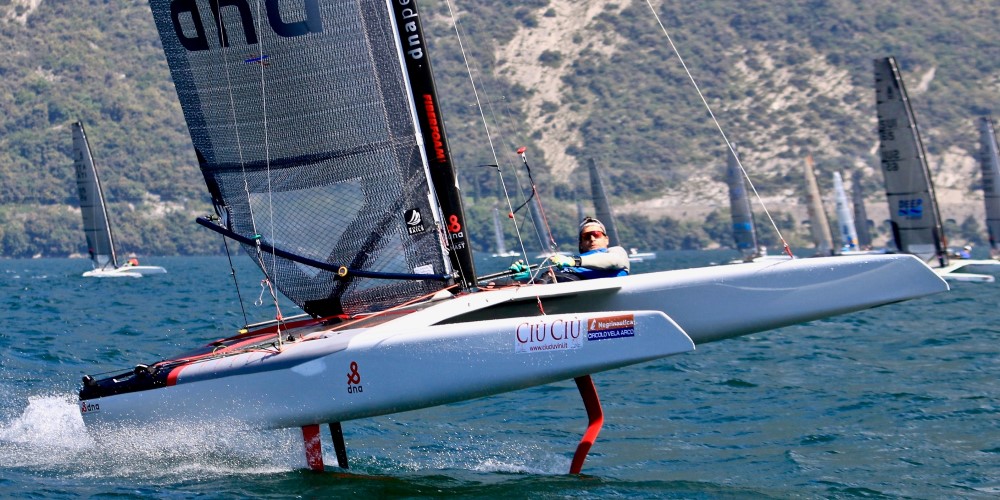
Contactformulier
- Company Name
- Full name * First Last
- Emailaddress *
- Phonenumber *
- Mijn vraag betreft * My question: TF10 F1x G4 F4 Custom Parts Hydrofoils Other
- Email This field is for validation purposes and should be left unchanged.
Registrieren Sie sich für unseren Newsletter
lassen Sie sich über die neuesten Entwicklungen informieren!
- E-Mail-Adresse *
- Phone This field is for validation purposes and should be left unchanged.
Schrijf je in voor onze nieuwsbrief
blijf op de hoogte van de nieuwste ontwikkelingen!
- First name *
- Last name *
- Comments This field is for validation purposes and should be left unchanged.
Wij gebruiken cookies om u de beste online ervaring te bieden. Door akkoord te gaan, accepteert u het gebruik van cookies in overeenstemming met ons cookiebeleid.
Wanneer u een website bezoekt, kan deze informatie in uw browser opslaan of ophalen, meestal in de vorm van cookies. Beheer hier uw persoonlijke cookiediensten.
- wordpress_test_cookie
- wordpress_logged_in_
- wordpress_sec

- FlySafe ® Foil Control
- iFLY Reviews
- Our Partners
- Distributors
- Class Association
Enter your keyword

“iFLY15 is the unique combination of high performance with easy accessibility – for maximum performance and maximum fun.”
Cec catamarans -ifly15 team, “we love speed while keeping control – high speed needs to be controllable. the flying boat of the future, is a stable foiling sport catamaran.”, cec catamarans – ifly15 team, „ foiling: one of the things you have to experience to really feel it. “, jimmy spithill, skipper oracle team usa, “stable flight is the key to high performance sailing”, “ifly15 – get the balance right between a nice sporting challenge and a reasonable and controllable level – enjoy the exhilaration, the speed and the adrenaline in your veins, but always stay master of the situation “, “stable flight attitude is the most important prerequisite for high performance sailing.”, victor diaz de leon, sailgp team usa, “stable flight attitude is key for easy foiling. ifly15 with superior flight stability delivers immediate flying fun within the first minutes. advantage through high-tech.”, “the ifly15 is the quickest boat around the course, … “, arno terra – sailor, ifly 15 one design and ifly razzor pro, the performance foiling catamaran, for maximum speed and maximum control.
- Easy access to a high HIGH PERFORMANCE FOILING CATAMARAN
- Automated DYNAMIC FLIGHT Assistance SYSTEM – FLYSAFE® FOIL CONTROL
- highest quality standards – High-tech full carbon sailboat
- completely modular – fully customizable
- adjustable rake – MAIN FOIL DIFFERENTIAL during sailing for even more performance in the version IFLY Razzor Pro
- Foiling Versatility and Speed …
The quality and performance have been proven for 8 years and further developed to maximum perfection in every detail
IFLY HYDROFOIL SAILING – EXCELLENCE, FIELD PROVEN TO PERFECTION
Racing and more …..
⦿ Have a high performance racing machine on regattas
⦿ single handed or double Foiling
⦿ crew weight up to 180 kg
⦿ Racing and fun:
⦿ Sail with Family & friends
in any sailing condition:
⦿ Full foiling – upwind and downwind
⦿ Waves and Flat waters
⦿ Light and strong winds
⦿ early take off
⦿ Foiling maneuvers
Transport and Facilities
⦿ Easily transportable on a road trailer
⦿ Slipped with a conventional beach trolley
⦿ ready to sail in 20 minutes
⦿ iFLY15 is designed to sail on the sea and lakes
Stay tuned for foiling events and specials!
Flysafe® Flight assistance
Main foil differential technology – mdt, innovative, sophisticated foil control for unbeaten performance, high speeds and easy access, ifly15 and ifly razzor pro, ifly main foil differential – mdt, ifly razzor pro.
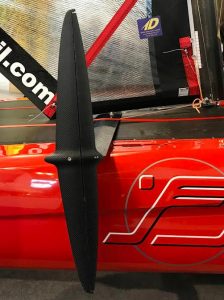
early take off in lightest breeze
F oiling maneuvers are heavily supported, superior flight attitude through active foil control, dynamic control of f light high , pitch and role, non-linear control and feedback control system for best flight stability, even in waves, the foils do not need to be manually manipulated, optimized performance: advanced sailors can adjust rake and gearing, more about flysafe®>>>, active flight assistance, the foil can be trimmed actively while sailing, the key to maximum performance , mdt for performance-orientated pro sailor, mdt extends the flysafe® foil control, to sail large xxl rigs, more about main foil differential ->>>, performance downwind: staying on the foils, full foiling, in 5-6kts tws, reaching max. boat speeds of up to 2.5*tws, performance upwind: full foiling from 8kts. tws, taking off from 7kts tws, video youtube channel, ifly15 foiling catamaran.

The most innovative development in foiling technology
About ifly15, stable flight is key for both: first for highest performance and foiling in a wide wind range, including rough and wavy conditions, but also easy access into foiling…...
iFLY stands for uniqueness in design and function. Its superior Flysafe ® active foil control system autonomously supports the stable horizontal flight position in the longitudinal and lateral direction. The 4 T-Foils do not have to be operated by the sailor during sailing.
Average skilled dinghy or catamaran sailors with some trapeze experience can safely foil with the iFLY15 after only a few hours. Quick access – the immediate sensation of success – steep learning curve. In the hand of an experienced sailor, iFLY15 offers a whole new sailing experience with previously not experienced speeds and agile maneuverability.
The flight control system, combined with numerous fine-tuned innovations , ensures safe foiling even in strong winds and rough seas.. Stable flight attitude allows pushing hard, so in good conditions, iFLY reaches high boat speed beyond 30 knots in a controllable way.
IFLY15 offers freedom to fly alone or in pairs. Due to the exclusive use of high-tech materials , iFLY15 is extremely rigid and weighs less than 90 kilos ready to sail. With its low weight and its state-of-the-art hydrofoils, it is airborne in winds as low as 2Bft. / 6 Knots.
iFLY15 has a length of only 15 feet, is easy to transport, quick to get ready to sail, and can be easily slipped from the beach using a conventional beach trolley.
Its sophisticated design reflects the highest demands on quality and function.
iFLY15 – customer reviews
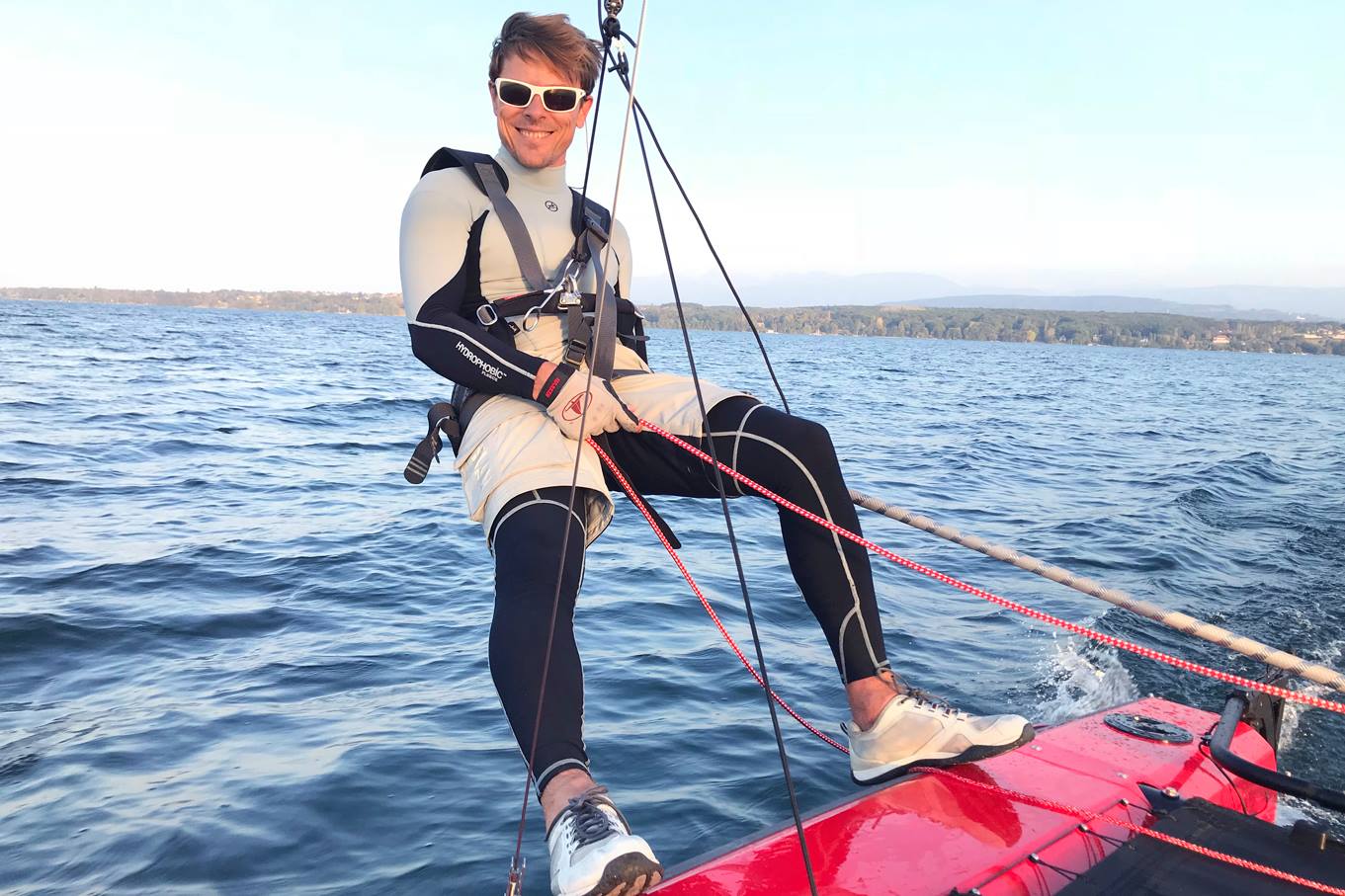
« LESS CRASHING IS MORE FUN »
MARCUS LYNCH, PROFESSIONAL SAILOR AND OLYMPIC COACH, GC32 OMAN, NACRA17
« I WAS INITIALLY AMAZED AT HOW EASY TO HANDLE THE IFLY IS AND AT HOW IDLE THE BOAT IS EVEN IN STRONG WINDS. »
ANTOINE, IFLY OWNER FROM GENEVA
VERY STABLE, EXTRAORDINARY STABLE. IT IS EXTREMELY INTERESTING, BECAUSE YOU IMMEDIATELY SEE THE ACCESSIBILITY OF THE BOAT.
FRANÇOIS GABART
« GREAT BOAT, LIKE A MOTH ON STEROIDS ! »
VICTOR DIAZ DE LEON, MIAMI, PROFESSIONAL SAILOR. US TEAM SAILGP, INTERNATIONAL MOTH, MATCHRACING MELGES 32, J70
WHAT A GREAT BOAT THIS IS, AND I ABSOLUTELY LOVE IT”
PHILIP WALKER
« THE DYNAMIC FLIGHT CONTROL SYSTEM ALLOWS LONG AND STABLE FLIGHTS »
GERHARD FLORIN, IFLY OWNER FROM GENEVA, SWITZERLAND
TO FELLOW SAILORS WHO LOVE THE THRILL OF SAILING WITH SPEED WHILE MAINTAINING CONTROL”
ROY BALLENTINE
« WELL BALANCED AND RAKE DIFFERENTIAL ALLOWING FOR GREAT PERFORMANCE UPWIND! »
CARLOS ROBLES,PROFESSIONAL SAILOR 49ER, PALMA DE MALLORCA
« A SENSATIONAL FOILING EXPERIENCE. THE SPEED IS IMPRESSIVE »
INGMAR WARNICKE: COMMODORE OF YCSO, YACHT CLUB SCHARBEUTZ, BALTIC SEA
⭐ ⭐ ⭐ ⭐ ⭐

IFLY RAZZOR PRO – THE NEW IFLY FOR EXPERIENCED SAILORS
THE SINCE 7 YEARS PROVEN IFLY15 WITH FLYSAFE® DYNMAMIC FOIL CONTROL has now a pur Racing fellow: THE iFLY RAZZOR Pro. THE iFLY racing VERSION ENABLES EVEN HIGHER PERFORMANCE, to sail in extremely tough conditions and allows sailing with XXL rigs. THE MAIN DIFFERENCE BETWEEN THE IFLY15 ONE DESIGN AND THE IFLY RAZZOR PRO IS A BIGGER RACING RIG, SPECIAL FOILS AND THE MAIN FOIL DIFFERENTIAL (MDT), WHICH IS MANUALLY TRIMMED BY THE SAILOR. THE MDT IS WORKING HAND IN HAND WITH THE FLYSAFE® DYNAMIC FOIL CONTROL SYSTEM.
flying – sailing – Blog
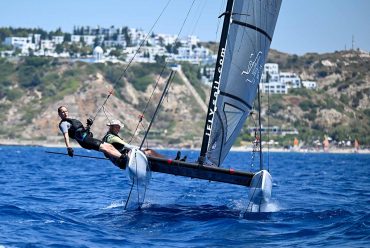
“We’re taking off! Foiling is THE Watersports Trend! – „Boot International 2024“ in Düsseldorf / Germany once again showcases: Foiling is THE trend in watersports.
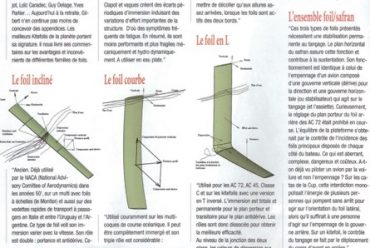
Performance Sailing – Sail GP News: Racing on the Edge – T-Foil proves to be the winning design

Regatta and foiling News: Long distance Race – Duc d’Albe 2023 – Club Multicoques Hyères – sailing Race @iFLY Razzor Pro
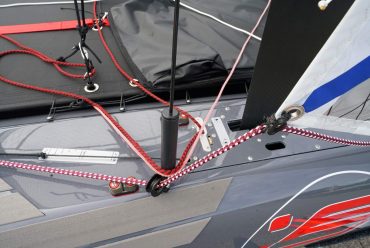
iFLY Main Foil Differential Technology – MDT Foil Control – high Performance sailing
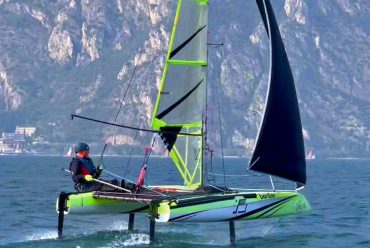
IFLY FOILING Adventure
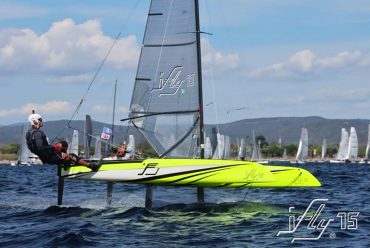
FOILING – REGATTA – EVENTS
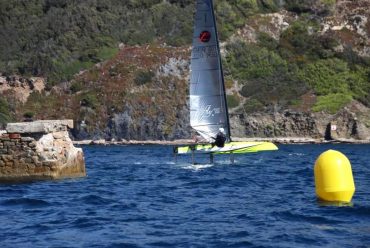
Long distance Race – Duc d’Albe 2021 – Club Multicoques Hyères – sailing Race @iFLY Razzor Pro
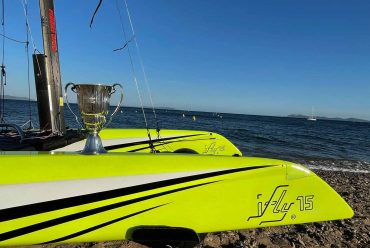
INTERNATIONAL IFLY foiling FLEET RACE 2021

iFLY15 successfully crossing the English channel / world record Attempt Cowes to Dinard / Saint Malo
Catamaran europe central, the iflysail team, is looking forward to your message.

Ready to get started?

Designed with a singular vision...To deliver unmatched performance and efficiency!
Introducing the insetta 35ifc – the bar has been raised.
The Insetta 35IFC was designed with a singular vision… to be the best-performing center console sport fishing catamaran in its class. Enjoy unmatched performance, range, and efficiency thanks to the 35IFC’s hydrofoil-assisted design.
In addition to being the best High-Performance Fishing Catamaran in its class, it also provides a smoother and dryer ride in the rough stuff!
This boat was designed for people who fish, by people who fish! From its integrated livewells to its cavernous coffin boxes, level open deck layout, massive insulated storage and so much more, this boat was designed for maximum range and fishability!
Here’s what our customers have to say: “Holy crap do I love my 35 IFC with the Merc 300 V8’s on the back. We ran her down to Key Largo the other day, snorkeled all day, got lunch at Shipwrecks Bar and Grill, and ran back. Cruised between 40 and 45 mph, mostly around 42. So smooth it’s nuts. Burned maaaayyybe 40 gallons for the whole day. As we cruised the dashboard was telling us between 1.7 and 1.8 mpg, but I’m pretty sure we cruised more than 40 miles and burned between 35 and 40 gallons, no more. So… suffice it to say that you guys have absolutely crushed it and changed the game here. Fantastic work”! – Alan, Hull #4
Check out our FAQ’s section below for more about the Insetta 35 with IFC!
Specifications
Length Overall
Maximum Beam
Maximum Draft
Fuel Capacity
Cruise Speed
Cruise Miles Per Gallon (MPG)
Over 850 miles*
Cruise Range
Standard Features
Standard “Insetta White” Gelcoat Molded in Diamond Non-Skid Tackle Storage Stbd Side Tackle Storage Port Side 19 Gallon Freshwater Washdown/Shower 5 x In Deck Storage Hatch 2 x In Deck Macerated Fish Boxes 625 Qt Insulated Coffin Box, Split Boxes Walk through Transom Access (Door Optional) Two 36 gallon Integrated Transom Livewells Fresh and Raw Water Washdown 34 Rod Holders (gunnels and coffin box) 7 Stainless Gemlux Pull-Up Cleats LED Navigation Lights Boarding Ladder
Recessed Stainless Bow Rail
Helm / Console
Fiberglass Hardtop with Powder Coated Aluminum Supports Tempered Safety Glass Enclosure for Console 6 Integral Rod Holders Built into Rear Support Molded Fiberglass Leaning Post with Rear Face Seating and cooler 3 Wide Helm Seats 6 S/S Cup Holders Storage Box and Rigging Tray on Rear Facing Seat Storage Drawers Under Helm Seats 165 Qt Leaning Post Ice Box Located Under Rear Face Seats
Base Upholstery
Equipment and Electronics
3 Part Internal Foil System
3 Pump Capacity Sea Chest with Dual Livewell Pumps & Raw Water Feed
4 1100 GPH Bilge Pumps (2 in Each Sponson)
Standard Capacities
490 gallon fuel capacity.
625 Qt Insulated Coffin Box with Divider
165 Qt Leaning Post Ice box
Dual 36 Gallon Livewells
19 Gallon Freshwater
Frequently Asked Questions
IFC is Insetta Boatwork's Internal Foiling System.
You can expect a significant increase in cruise speed; Improved handling and stability in rough conditions; Better acceleration; A boat that is less affected by increased payload; A 20-40% increase in fuel efficiency; and a 20-40% further cruise range! Additionally, the IFC technology will also provide a drier ride in choppy conditions and Provide for more responsiveness when turning at speed!
The system is a fixed setup, there is nothing to operate and there are zero moving parts.
The IFC Technology in effect smooths out rough seas by allowing the boat to run from wave crest to wave crest at a relatively smooth and stable attitude. The IFC System creates lift which help to in effect “Carry” the hull higher in the water. The system acts as a set of wings carrying the boat at speed, keeping the hull from having to follow each wave across its entire contour. In other words the surface of the waves have less effect on the hull as the IFC system is lifting the boat. Additionally, the aerodynamic lift created by the catamaran hulls creates even more lift at the bow of the boat, keeping the nose high and preventing the “slamming” or sneezing found in other catamaran hulls.
No, you don’t. The foils are flush mounted to the bottom of the keels of each sponson (as well as up in the tunnel.) At its centerline the main foil of the IFC system is only slightly lower than the keel line. The boat will easily load onto a standard catamaran trailer. There is no big contraption hanging way down under the boat.
Remember, the foils are INTERNAL to the tunnel. At its lowest point the main foil is only slightly lower than the hull and is higher than the props. Because of this the odds of striking the foils are extremely low. The boat is designed to be lifted by the foil. The structural integrity of the foil system is such that the weight of the boat could be supported many times over by the foil. As such, if you did somehow manage to strike the foil on something EXTREMELY SUBSTANTIAL, like a stone shoal, the likely outcome is that you may (in a very worst case scenario) bend or break a foil wing. If that were to happen, you could still operate the boat to port with the remaining foils. The IFC foils are made from a very high-grade stainless steel and designed to meet or exceed relevant guidelines for impact and strength.
As water travels through the tunnel and around the foil, a tremendous vortex is created. This force keeps most debris from being trapped in the tunnel or around the foil. Between the pressure of the air moving through the tunnel, and the vortex created in the water, the tunnel and foils will stay clean and clear.
The outboards of the 35 IFC are mounted on a slight outward angle to place the propellers properly to maximize the thrust and flow efficiency created as the water travels through the tunnel and around the foils. This mounting also helps the boat to lean into a corner, much like a monohull.
Firstly, we’d ask, “Why would you want to?” But the short answer is no. IFC is an integrated system that is integral to the design of the boat.
The short answer is that boats with technology similar to IFC have been in use for many years, but not in the recreational market. Commercial and Military applications are quite prevalent. The initial design of a hull and system like this is quite complex and can be cost prohibitive. We at Insetta feel the gains in efficiency, speed, range and ride quality far outweigh the initial design and build cost.
Upon deciding to build a foiling Cat, Insetta assembled a team of naval Architects and Marine Engineers to refine an existing and proven design. Using their own state of the art construction techniques, Insetta brought an application specific version to the fiberglass Center Console market.
Optional Features
Customizable Garmin or Simrad Electronics JL Audio 10 Speaker Stereo System Flush Mount Acrylic Helm Bow Shade Custom Gelcoat or Combination of Colors Deluxe Upholstery Third Center Livewell Under Rear Facing Seat 40 gallon Seadek Flooring or Flexiteek Decking Additional Gunnel Rod Holders (18 standard) Recessed Wireless Phone Chargers Swivel Base Rod Holders Outlets for Electric Reels Additional Drink Holders on Leaning Post, Coffin Box, Gunnels and Helm Forward/Rear/Side Spreader Lights T-Top Outrigger Bases/Poles Gemlux Electric Head With 19 Gallon Blackwater Holding Tank Freshwater Sink and Vanity Inside Console Underwater Lights Heavy Duty Dive Ladder LED Under Gunnel Lighting On-Board Battery Charger Windlass Custom Aluminum Trailer Cockpit Table/Bow Table
Why did Insetta Boatworks decide to build a boat with IFC?
For decades, Hydrofoil power boats have proven to be the most efficient craft for a variety of offshore operations.
While pursuing a B.S. in physics in 1960, Victor Insetta was employed doing anti-submarine research that utilized high speed Deep-V patrol boats equipped with hydrofoils. Their ability to pursue submarines at high speed, operate safely offshore, and, being foil borne: allowed their hull to run clear of the water avoiding direct hits from torpedoes. Decades later, Vic and his family rode comfortably on hydrofoil ferries in Italy, flying over white capped waves in the bay of Naples.
In 2017, The Insetta 45 was chosen to be the official chase boat of the America’s cup! Four 45’ Insetta’s catamarans were shipped to Bermuda to assist at various cup events. Sailboats, competing from several countries, were catamarans with hydrofoils ! The Insetta 45’s ran parallel to these “foiling sail cats” to assist with TV coverage. The sailing cats were traveling at speeds approaching 50 mph, 2 ½ times the wind speed . Efficient … you bet . They could also turn on a dime at over 40 mph…
It became obvious: that a foiling cat would make a great offshore outboard power boat… Many foil power boat designs in the past, had wide foils that stuck out the sides, increasing their beam and draft. It made them difficult to dock, and they couldn’t operate in shallow waters. Joel Shine (chief operating officer) of Insetta Boatworks found a catamaran design that had hydrofoils mounted in the tunnel, (that location between the tunnel walls actually improves their efficiency), and does not add to its draft. Further improvements could be added by using our ultra-light high strength infused composite construction.
Joel, Vic and our technical staff reviewed the foiling cat’s initial specifications and performance data, and then sea trialed two foiling cats with internal hydrofoils. Our staff includes a second physicist and pilot… Glen Dobbs. We are all active boaters and we determined we would build our version of a foiling outboard powered cat. We contacted a Naval architect, who designed several successful foiling power cats . He is now a member of our technical staff.
Our 35 “foiling cat” design has set the standard for Foil-Assisted Sportfishing boats. The hull, foils, materials, and engines are synergistically combined, to provide: unrivaled high-speed cruising efficiency , and provide safe offshore handling, with unimpeded shallow water operation, including beaching, without foils or props contacting the bottom.
Insetta 35IFC
The premier internal foiling catamaran.

Integrated 36 Gallon Livewells & 625 QT Coffin Box Standard
Designed to fish.

850+ Mile Range!

Best in Class MPG, Smoother/Dryer Ride!
Performance.
Click the button below to contact or email us for more info!
Latest News

The Foiling Press – February 2024
The Foiling Press – February 2024 – February was a busy month for…

The Foiling Press – January 2024
We kicked off the year with a full house here at Insetta Boatworks! Three beautiful 35IFC’s in…

The Foiling Press – December 2023
The Foiling Press – December 2023 – We’ve wrapped up an incredible year…

The Foiling Press – March 2024
The Foiling Press – March 2024 – Spring is in the air and…
Get the Latest Insetta News!
- First Name *
- Last Name *
Share this page

Looking for our latest catalog?

IMAGES
VIDEO
COMMENTS
En planche, en kite, en dériveur ou en catamaran, l'école de foil de l'UCPA c'est : - pratiquer au cours de stages spécifiques - découvrir les supports à la fin des stages classiques ... l'UCPA reste à la pointe de l'innovation en créant une filière "Ecole de Foil UCPA" dédiée aux engins nautiques à FOIL.
Le foil est un aileron spécifique qui vient s'adapter à la coque d'un bateau (catamaran, dériveur) ou à la planche d'une planche à voile ou d'un kitesurf. Cet aileron permet à l'engin de quitter la surface de l'eau limitant ainsi les frottements et le bruit. Le ou les foils, deviennent alors le seul point d'appui de l'engin.
Toutes les infos pratiques (âge, matériel, niveaux, sécurité) dans nos centres UCPA Séjour Foil : découvrez les centres UCPA Vous êtes connecté pour le compte de: {{ auth.user.firstname }} {{ auth.user.lastname }} sur le site GROUPES Déconnexion
A much smaller trim foil (or foils) is then located near the stern of the catamaran and again, this/these can be set up at a fixed angle or can be adjustable to vary the trim angle of the boat and the angle of attack of a fixed main foil. Generally this system is designed to carry approximately half the displacement of the vessel at maximum speed.
His latest project is a 29' (8.8m) foil-assisted planing cruising power catamaran designed for twin outboards from 60 hp to 90 hp. Last fall, construction was far advanced as Brandt prepped for finishing, outfitting, and getting the boat ready for sea trials off St. Augustine, ... The centerpiece of the foil project is a 20 ...
The Foil Cat holds 400 gallons of fuel and with twin Mercury 400 Verado engines, has a 600-700-mile range, cruising at an easy 32 mph. That horsepower and speed provides an economical 2 mpg burn. The amidship location of the 28" foils come into play as the boat planes, balancing the amount of boat in the water, both foils and propulsion units ...
Highlights of iFLY15 @ 2019 French Foiling Event. Hydrofoil speed sailing.World class stable foiling."La Semaine Affoilante" (French week of foiling) and Foiling experience @ UCPA sport center Hyères.Revolution of FlySafe® active foil control, allowing top speeds AND full control / easy accessibility.
Vous débutez en wing foil ? Vous voulez des conseils ? On vous guide dans votre apprentissage avec les tutos wing foil - UCPA Bombannes x FOIL&CO ! ⬇⬇⬇FOIL&C...
Catamaran Sailing. Catamaran Sailing, or 'Cat Sailing' for short is the fastest, most exciting form of small boat sailing. UCPA have a large range of Hobie Cat 16's which will help you learn the basics of rigging, launching, tacking, gybing, sailing upwind and sailing downwind.
2 sites d'hébergement : Ecole de Mer de Port-Camargue ou le camp UCPA au Camping de l'Espiguette. (suivant la période et l'âge de l'enfant) Stages adultes : Mai-Juin et week-ends. Juillet à fin septembre : en semaine. Accueil séjours groupes, CE, séminaires .. toute l'année à l'Ecole de Mer. Renseignements et réservations au 03 28 82 ...
The FoilCat Team is relentlessly dedicated in our pursuit of the ultimate user experience accentuated by the highest performance and safety standards throughout the marine industry. A RIDE LIKE NO OTHER. The foil greatly improves ride quality and efficiency. Reduction in operator and passenger injury and fatigue.
Hydrofoil catamarans can reach speeds of up to 40 knots (46 mph) or more, depending on the design and conditions. The foils on a hydrofoil catamaran can lift the hulls out of the water, reducing drag and allowing for a smoother and faster ride. Hydrofoil catamarans are used for various purposes, including racing, recreational sailing, and even ...
Le foil est à la base l'aileron qui vient s'adapter soit à la coque d'un bateau (catamaran, dériveur), soit à la planche d'une planche à voile ou d'un kitesurf. Grâce à son aérodynamisme exceptionnel, il permet de se maintenir littéralement dans les airs, au-dessus de la surface de l'eau. Plus un bruit, pas un frottement,
Hydrofoil beach-catamaran to fly across the Channel - More Info >> After iFLY15 - Great Britain Tour 2019 // From 5th of September the iFLY15 will be on standby for a favourable weather window at Stokes Bay Sailing Club. The boat is on public display from the 1st of September and for test sailing. ... UCPA Hyères is now iFLY15 sailing center ...
Découvrez l'UCPA de Port-Camargue et ses superbes spots de #Kitesurf, #KiteFoil, #Windsurf, #Windfoil, #Wingfoil, #Catamaran, #Yoga, #Yoga-Paddle, #Stand-Up ...
The solution on the Eagle Class 53 was to create a composite wingmast where 50% of the area is a solid D-section and the trailing 50% a soft sail that can be raised, lowered and reefed ...
flySafe® dynamic foil control system. The foils are controlled independently, dynamically and precisely on both sides by the flySafe® foil control system. This enables high performance sailing through stable flight. The unique foil control system of IFLY15 is a 7 years proven system developed by CEC Catamarans. Know More >>>.
Technical details. The F1x A-class foiling catamaran has a number of unique features that improve performance. For example: Semi ridged trampoline. Gives extra torsional stiffness to the boat and increases its aerodynamic characteristics. Patented main-sheet-wheel-system. For more direct and faster trim of the main sail.
The flight control system, combined with numerous fine-tuned innovations, ensures safe foiling even in strong winds and rough seas.. Stable flight attitude allows pushing hard, so in good conditions, iFLY reaches high boat speed beyond 30 knots in a controllable way. IFLY15 offers freedom to fly alone or in pairs.
Avec Sensation foil embarquez sur un catamaran à foil!! top of page. Sensation foil. Accueil. Votre entraîneur. Nos bateaux. Cours et location. Nos formules et tarifs. Localisation. Carte cadeau. Plus. [email protected]. 06.81.89.05.61. Se connecter. Sensation foil vous souhaite la bienvenue ...
The Insetta 35IFC was designed with a singular vision… to be the best-performing center console sport fishing catamaran in its class. Enjoy unmatched performance, range, and efficiency thanks to the 35IFC's hydrofoil-assisted design. In addition to being the best High-Performance Fishing Catamaran in its class, it also provides a smoother ...